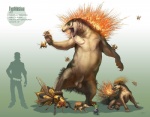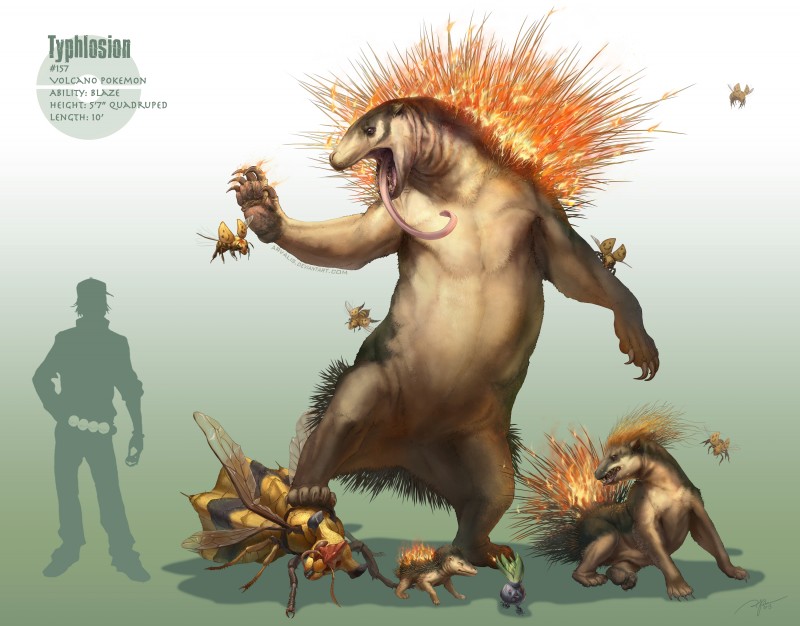
Description
Though Typhlosion has a similar appearance to that of an Ursaring, it has actually be discovered their closest living relatives are Dewgongs. One only need to look to the diet of a Typhlosion to uncover the reason for its bizarre appearance. Typhlosion feed primarily on Combees and honey from Combee hives. The average Combee can easily reach a foot in height, thus their hives are immense. As their hives are so grand, one hive can easily feed a few full grown Typhlosions regularly and still not collapse. The tongue of a Typhlosion is used to probe deep within honeycombs of the hive. The wax of the Combee hive, when consumed leads to a unique chemical reaction cause the saliva of Typhlosion to become flammable. They use their lengthy tongue to coat their mantle of quills, then using specialized "flint teeth", they crunch their teeth to produce sparks. The fire retardant coat and quills of a Typhlosion do not burn easily so once lit by their sparking jaws, they will put on quite the display for some time. Typhlosions have been observed ripping openings in hives, putting their entire head inside, leaving their body exposed. It is proposed that their flaming mantle quills were developed just for this behavior as Combees are much less inclined to attack something on fire. Not that it would do them much good regardless, Combee stings have little effect on a fully grown Typhlosion. The quills of the Typhlosion family can be shed when burned for too long(cinder quills), or come in contact with an attacker. As seen here, Typhlosion is demonstrating a baiting behavior. It will occasionally seek out Vespiquens and kill them to draw out many more Combees to slake its insatiable hunger even after it has gorged itself on honey. Typhlosions in captivity are known to be big ol' softies though, look at his cute face; you can't say no to that face.
Adolescent Typhlosions are known as Quilavas. Though Typhlosions exhibit an unprecedented length of parental care, Quilavas become very rebellious against their family group as they age. These youthful Typhlosions actively seek to find new hives, trying to establish themselves as independent. As a result of this these Pokemon are known for being difficult to deal with until they reach maturity. One can see here how a Quilava can chomp their teeth together to create a flurry of sparks to ignite their quills.
The infant stage of Typhlosion is known as a Cyndaquil. These very young Pokemon don't often leave the care of their nurturing parents. They quickly ween off their mother's milk in favor of honey. Cyndaquil seldom open their eyes in the care of they parents or trainers unless threatened. Look at how playful Cyndaquil is, Oddishes just don't get their sense of humor.
Oddish is a Plantiform. It was only scientifically observed 43 years ago that Oddish was anything more than a common flower bulb. Plantiforms are highly developed plants that blur the line between flora and fauna. They have the ability to move, albeit slowly, and even has rudimentary vision. Other confirmed Plantiforms include Exeggutor, Sunflora, and Roselia. These "living plants" are subject to intense scientific discussion, and lead to a reexamination of the vegan and vegetarian movements.

Daneasaur
MemberThank you. For some reason DA shat brix and gave a 404 when I tried to get the full size.
Login to respond »